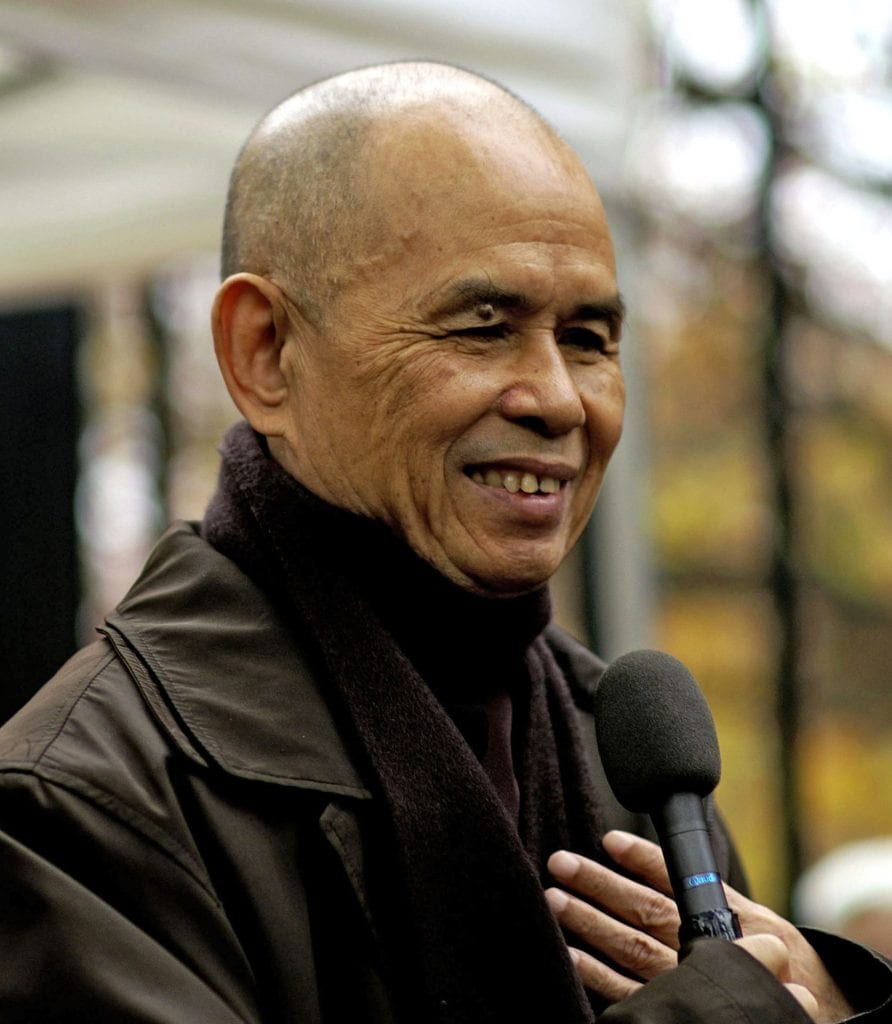
Thich Nhat Hanh in Paris, 2006 , WikiMedia Commons.
Today, October 11, we celebrate the 95th birthday of the Vietnamese Buddhist monk Thich Nhat Hanh, affectionately known as Thay.
At age sixteen, in 1942, Thay entered Tu Hieu Temple, in Hue city, as a novice monk. His life has since been dedicated to the practice of mindfulness, compassion, meditation, and creative expression for the benefit of all living beings.
According to “The Story of Thich Nhat Hanh” (on the Plum Village website, ):
“When war came to Vietnam, monks and nuns were confronted with the question of whether to adhere to the contemplative life and stay meditating in the monasteries, or to help those around them suffering under the bombings and turmoil of war.” plumvillage.org/about/thich-nhat-hanh/biography/
Choosing both paths, Thay founded the Engaged Buddhism movement, deeply impacting millions of people throughout the world.
East and West
In 1961 Thay came to the United States, to teach Buddhism at Princeton and Columbia, and to advocate for peace in his country and internationally. He returned to Vietnam in 1963 to play a leading role in the Buddhist movement for peace and humanitarian service based on principles of nonviolence and compassionate action.
After receiving Dharma transmission on May 1st, 1966 at Tu Hieu Temple, Thay returned to the U.S. and Europe to advocate for peace, calling for an end to hostilities in Vietnam. During this 1966 trip that he met Dr Martin Luther King Jr., beginning a relationship that would profoundly impact both men, and the world.
In response to his peace mission to the West, both North and South Vietnam denied Thay the right to return to his country – forcing him into an exile of 39 years. During this time, he continued his prophetic call for peace, and his advocacy to end the War in Vietnam. In 1969, he led the Buddhist delegation to the Paris Peace Talks in 1969.
In France he taught Buddhism at the University of Sorbonne, Paris, and in 1982 he established the Plum Village spiritual community in southwest France, perhaps the most active Buddhist monastery, retreat center and community in the world today.
Return to Vietnam
On 11 November 2014, a month after his 88th birthday, Thay suffered a severe stroke. Following extensive rehabilitation, he returned to Vietnam in October 2018.
“Thich Nhat Hanh is currently residing at Từ Hiếu Temple in Vietnam where he ordained with his teacher when he was sixteen years old. He has expressed a wish to stay there for his remaining days. He comes out regularly in his wheelchair to visit the temple altars and to lead the sangha on walking meditation around the ponds and ancestral stupas. Thay’s return to Từ Hiếu has been a bell of mindfulness reminding us all of how precious it is to belong to a spiritual lineage with deep roots.”
https://plumvillage.org/about/thich-nhat-hanh/biography/
Nonviolence: our North Star
Just last week, Thich Nhat Hanh published a powerful new book: Zen and the Art of Saving the Planet. It is a profound and immensely moving cri du coeur.
Sister True Dedication, a Dharma Teacher ordained by Thay, frames the book’s message:
“In the 1960s, Thay created a movement of thousands of young social workers in Vietnam. before leaving for the West to call for peace. A leading voice for nonviolent social change, he collaborated with Dr. Martin Luther King, Jr. with whom he shared a vision for building a ‘beloved community’ that could transcend division, discrimination, and hatred – a community in which true reconciliation can be possible, among all people and among all nations….
In this very moment, we face a potent intersection of crises: ecological destruction, climate breakdown, rising inequality, exploitation, racial injustice, and the lasting impact of a devastating pandemic. The situation is beyond urgent.”
Thay calls on all of us to wake up and heal our broken world before it is too late.
How can we do this? What is our path?
Thay calls nonviolence our “North Star.”
“Our enemy is not other people,” Thay pleads. “Our enemy is hatred, violence, discrimination, and fear.”
We must fight this enemy through mindfulness and nonviolent resistance.
“When you witness a lot of violence, discrimination, hatred and jealousy, it is your understanding and compassion that protect you…,” Thay writes.
“Compassion can protect you better even than guns and bombs. With compassion in your heart, you will not react in fear or anger and you will attract much less danger to yourself. If you’re angry, you make others afraid, and when they’re afraid, they attack because they’re afraid you will attack first. So, compassion protects both you and the other person. If you can produce compassion and prevent violence, that is a victory – a victory for both parties.”
Thay urges us to see that, through compassion, we can transform violence, fanaticism, and dogmatism in ourselves and in the world.
In tomorrow’s blog posting, I will discuss in detail how Thay influenced Dr. King to oppose the War in Vietnam, a fateful decision for King and for our nation, how Dr. King impacted Thay in turn, and why it is imperative that we follow the path they forged together.
Jonathan D. Greenberg
